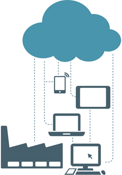
Technology
MES is seldom used as a stand-alone system. A typical solution is to place the MES system between the ERP and automation (DCS, PLC) systems. Sometimes the solution includes a separate product data management (PDM) system, a maintenance system, or a separate advanced planning and scheduling (APS) system.
MES systems are therefore required to have a high degree of integration capability. Interfaces to automation can often be built on the basis of standards. SyncMES® supports several automation protocols, such as OPC, OPC UA, MQTT. The system also includes built-in system-specific interfaces for several automation manufacturers.
ERP interfaces require flexibility, which is normally provided by the MES. SyncMES® supports an ERP-MES interface for systems such as SAP, D365 Business Central, IFS, and Visma Nova. The interfaces can be implemented using different protocols or file formats, such as REST/Json, web services, XML, BizTalk, MQSeries, sftp/ftp, Excel, csv and several others.

Scalability and a browser-based user interface are basic requirements, but they are also hallmarks of a future-proof architecture.
Ease of use is an important criterion in user interface design. Different user groups participate in the factory's production, and they receive information according to their role for timely decisions and measures. Access to information according to user roles and easy management and integration into the company's common user management are basic functions.

In addition to local information system delivery, SyncMES® can also be delivered as software as a service (SaaS) cloud delivery designed for production-critical industrial environments. Our cloud-based service solution is designed to ensure the uninterrupted continuation of production in all situations. At the same time, you benefit from the ease and affordability of the cloud delivery.